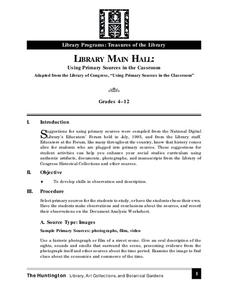Curated OER
Mystery of the Maya
Pupils research the Mayan civilization and complete an artifact dig. In this archeology lesson, students watch an IMAX video about the Mayan civilization. Pupils discuss archaeology related vocabulary and then work in teams to complete...
Curated OER
Then and Now: Art or Fact
Students complete worksheets about Parliamentary procedure and institutions. They research artifacts, and write a class play based on one artifact.
Curated OER
Lincoln Home National Historic Site: A Place of Growth and Memory
Eighth graders study the history of Lincoln's home. In this American History lesson, 8th graders examine artifacts from his home to learn about his beliefs. Students participate in a webquest on Lincoln's home.
Curated OER
Beauty
Students bring an object to school that is of significant sentimental value to them. They arrange the objects in a class display, examine each other's artifacts and discuss the implications and cultural bias of the word 'beauty'.
Curated OER
Exploring Historic Cemeteries
Students explore how artifacts vary at different times and in different places. They examine gravestones, observe both the individual markers and the larger context or setting of the graves.
Curated OER
State of Mind: Inventing the American Identity
Pupils define national identity, explain importance of having national identity, describe America's national identity, work together and formulate class vision of what America's national identity is, identify United States symbols and...
Curated OER
Family: The Circle of Life
Students brainstorm family meal traditions and the meaning of "The Circle of Life" while viewing artifacts. They plan a traditional family Thanksgiving meal and write/discuss their own Thanksgiving family meal traditions. Students listen...
Curated OER
Inventor's Project
Students conduct research about different inventors and their inventions. They use various types of resources to obtain information. Students use the information to create a class museum that contains artifacts, written reports, or models.
Curated OER
The Uluburun Shipwreck Project: Interconnections through Trade in the Late Bronze Age Mediterranean World
Ninth graders examine causes and effects of the Uluburun shipwreck. In groups, they develop their own ways to categorize the artifacts found on the ship and decide on the research questions they are going to focus on. They use the...
Curated OER
Using Evidence from a Shipwreck to Explore Late Bronze Age Trade in the Mediterranean
Young scholars examine a shipwreck from the late Bronze Age. As a class, they view a variety of slides to describe the cargo and examine the artifacts found on the wreckage. They discuss what each object tells them about the crew and...
Curated OER
Long, Long, Ago
Students discover details of pioneer life. In this history lesson, students examine artifacts and play games from pioneer times.
Curated OER
"How to Think Like an Archaeologist" - Suggested Pre-Visit Activity For Historic Jamestown
Learners examine how archaeologists use artifacts to explore other people and their cultures. They discuss types of artifacts, analyze receipts for clues, and discuss how what the items bought reflect about people.
Curated OER
The "Me" Exhibit
Students collects artifacts from home that they feel describe themselves. They write captions for each artifact and display them for their classmates.
Curated OER
History Detective: The Case of the Mysterious Trunk
Students role play as history detectives. In this historical inquiry lesson, students discuss what detectives do, analyze a trunk of "artifacts" and make conclusions about its fictional owner. Students complete six pages of related art,...
Curated OER
Ancient Egypt
This lesson plan template aligns with the TechnoMummy curriculum and resources, but includes great ideas to use without the curriculum. During this lesson plan on Ancient Egypt, students will become Egyptologists and learn about ancient...
Curated OER
Tag It and Bag It: Archeology Lab Lesson
Seventh graders practice analyzing, collecting and categorizing artifacts. Using charts, they organize and interpret information about the artifacts they classified. They work together to create a graph to represent class totals and...
Curated OER
What Can We Learn From the Past?
Learners observe items from their past, making inferences and observations about their own culture based on these artifacts. Students then share with the class what they learned about their own culture, giving all learners more...
Curated OER
Conversing with an Object
Students analyze museum artifacts and create conversations between these inanimate objects using prior historical knowledge. In this museum artifact instructional activity, students create theoretical dialogue between historical...
Curated OER
A Race Against Time
Pupils explore the act of preservation first in the process of preserving food and then in the preservation of historic sites, buildings, landmarks, and artifacts.
Curated OER
Searching the Attic
Students investigate an attic or basement to "discover" family artifacts. They develop a grid map using string, create a naming system for the grid, and analyze items of interest.
Curated OER
A Reporter's Recovery of Place
Learners read and write their own story about an artifact they find in their community.
Curated OER
Revive, Contemplate, Integrate
Students recognize flags as a symbol through writing and imagery. In this artifact lesson plan, students investigate Tibetan prayer flags and their significance. Students create personal prayer flags and write about their life experience...
Curated OER
Using Primary Sources in the Classroom
Scholars study a historical photograph to make predictions of what happened right after the picture was taken. They research a variety of different topics and use primary sources to answer questions about common food, fashion trends, and...
NOAA
I Can't Breathe!
The Gulf of Mexico dead zone, an area of low oxygen that kills marine life, costs the United States $82 million every year. Young scientists research anoxic ocean environments then come up with a hypothesis for the cause of the Gulf of...

























